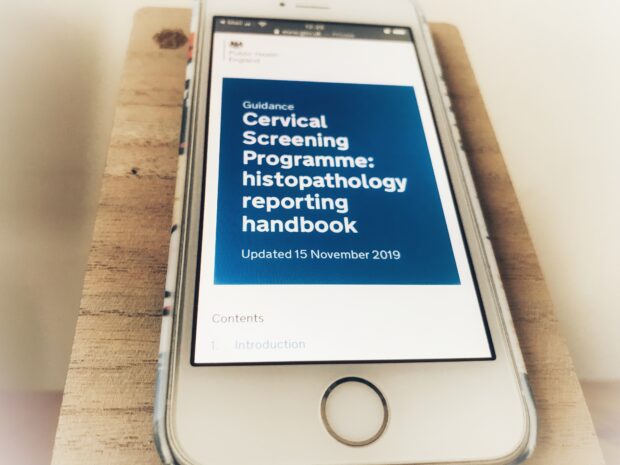
We are pleased to announce the publication of new guidance for pathologists who report cervical biopsy samples for the NHS Cervical Screening Programme (NHS CSP).
The cervical screening: histopathology reporting handbook sets out a comprehensive approach to histopathology reporting and replaces the second edition of ‘Histopathology reporting in cervical screening: an integrated approach’ published in 2012.
The new publication includes additional standards to promote an improved service through consistency of diagnosis in histopathology in cervical screening.
We will continue to review and revise this guidance as primary HPV embeds into the NHS CSP.
What's in it
The additional standards cover:
- defining the adequacy of cervical biopsies and when they must be called inadequate
- monitoring reporting profiles for cervical biopsies and loop excisions
- the use of p16 staining
- the use of minimum data sets to standardise report content
- the introduction of minimum workload figures for pathologists who report programme generated histopathology samples
- histopathology input to the colposcopy multidisciplinary team (MDT) meetings
- professional updating in cervical histopathology
- clarification of the lead pathologist’s role for cervical screening histopathology
- audit as an integral part of a pathologist’s work
- outsourcing and the use of locums
- monitoring turnaround times (TATs) for cervical histopathology
Pathologists
Pathologists reporting cervical biopsy samples perform a vital role in the NHS CSP.
Currently, many general histopathology external quality assessment (EQA) schemes do not regularly include cervical biopsies. This can make it difficult for some pathologists to comply with the Royal College of Pathologists’ requirements for continuing professional development.
PHE Screening is supporting the development of an e-learning module by the British Association of Gynaecological Pathologists to address this disparity. Pathologists will be able to undertake the e-learning every 2 years. The e-learning will include morphology and screening programme components.
We expect this to be ready by spring 2020 and will give you an update nearer the time.
Get in touch with the PHE screening helpdesk for more information.
Special thanks
We would like to give special thanks to all of our contributors: Dr Paul Cross, Dr Karin Denton, Dr Steve Ferryman, Dr Raji Ganesan and Jackie Jamison.
We would also like to thank colleagues – past and present – from the clinical and professional groups (colposcopy and laboratories), the Royal College of Pathologists (RCPath), the British Association of Gynaecological Pathologists (BAGP) and the British Society for Colposcopy and Cervical Pathology (BSCCP).
Once again, special thanks to Dr Steve Ferryman for all his help and generous support with this work.
PHE Screening blogs
PHE Screening blogs provide up to date news from all NHS screening programmes. You can register to receive updates direct to your inbox, so there’s no need to keep checking for new blogs. If you have any questions about this blog article, or about population screening in England, please contact the PHE screening helpdesk.